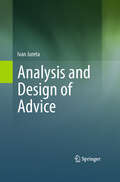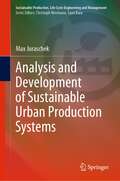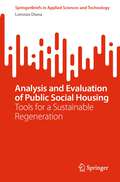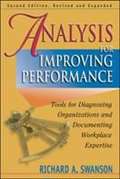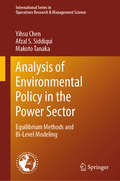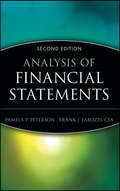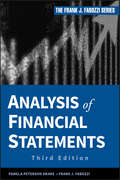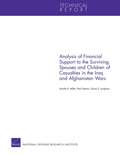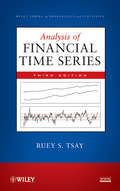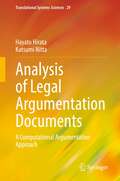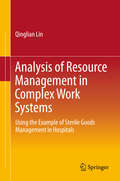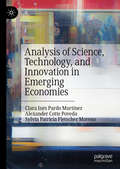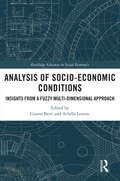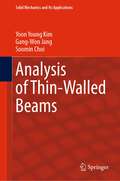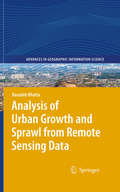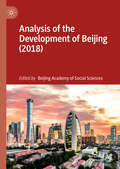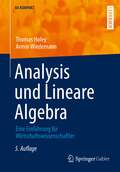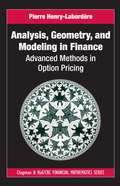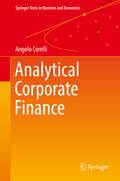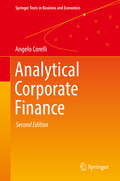- Table View
- List View
Analysis and Design of Advice
by Ivan JuretaThis innovative book offers a rigorous approach to the analysis and design of advice in real-world decision situations, in which the advisor must manage with variously imprecise, unclear, incomplete or conflicting qualitative information.
Analysis and Development of Sustainable Urban Production Systems (Sustainable Production, Life Cycle Engineering and Management)
by Max JuraschekManufacturing of products in urban production sites is connected to unique potentials, yet also to specific challenges. Urban factories can provide functional diversity and contribute positive impacts to a city. The concept of urban production receives rising attention in research and industry and it is recognized in its interdisciplinary nature. With a holistic approach from both the urban perspective and the factory perspective, negative impacts can be minimized, positive effects enabled and mutually beneficial, symbiotic combinations created. The presented framework and methods for the evaluation and implementation of sustainable urban production systems allow the assessment of impacts and provide the means to control and utilize the unique strengths of urban factories for cities and industry. This will allow a structured derivation of methods and measures from the concept of urban production for producing enterprises and the urban stakeholders.
Analysis and Evaluation of Public Social Housing: Tools for a Sustainable Regeneration (SpringerBriefs in Applied Sciences and Technology)
by Lorenzo DianaThe book explores current characteristics of the urban built environment in view of possible future transformations. A cross-reading analysis of existing public social housing buildings is proposed, based on the investigation of their architectural, structural, and energetic characteristics. The study aims to provide an integrated approach that captures the link between typology, construction, and energy demands, offering a key to understanding the main critical issues and transformation readiness. It focuses on large-scale interventions composing public social housing stocks, realized during the second half of the twentieth century. More than other public interventions, such building stocks clearly lack in meeting current housing needs such as modern apartment architectural layout, energy and structural regulations, and social mix. However, due to their numerical presence, strategical and widespread distribution across urban areas, and transformability, these buildings can be the target for future strategic regeneration projects. In particular, the book thoroughly investigates the social housing estate constructed in Rome (Italy) after the approval in 1964 of the first urban economic and social housing plan.
Analysis for Improving Performance: Tools for Diagnosing Organizations and Documenting Workplace Expertise (2nd edition)
by Richard A. SwansonSwanson describes a systematic approach that helps program developers and managers to lay the groundwork necessary for ensuring the success of organizational performance improvement efforts. The focus is on the analysis phase, during which current organizational performance is diagnosed and workplace expertise is documented. A new chapter on documenting and improving work processes has been added for the second edition. Swanson teaches human resource development at the U. of Texas at Tyler. Annotation ©2007 Book News, Inc., Portland, OR (booknews.com)
Analysis of Environmental Policy in the Power Sector: Equilibrium Methods and Bi-Level Modeling (International Series in Operations Research & Management Science #292)
by Afzal S. Siddiqui Yihsu Chen Makoto TanakaThis book covers game-theoretic approaches to analyzing policies for environmental regulation in the power sector. The scope includes operational and investment decisions in imperfectly competitive electricity markets as well as transmission planning and policy design. Given this context, this book synthesizes equilibrium and bi-level modeling to address challenging research questions such as: • How are power-plant operations affected by carbon policy, such as cap-and-trade (C&T) systems? • How does market power in electricity generation affect market outcomes and CO2 emissions? • How does a strategic firm with first-mover advantage manipulate both electricity and C&T permit prices? • How does a strategic firm with first-mover advantage invest in new generation capacity under a C&T system? • How does sustainable transmission planning adapt to an imperfectly competitive power sector? • How should a renewable portfolio standard (RPS) target be revised in an imperfectly competitive power sector? This book includes plenty of illustrative examples to facilitate the concepts’ comprehension. It is intended to make equilibrium and bi-level models adapted for policy assessment accessible to graduate students, academic researchers, industry practitioners, and policy analysts.
Analysis of Financial Statements
by Frank J. Fabozzi Pamela P. PetersonRevised and up to date, the Second Edition includes valuable information that addresses questions such as: * What is transparency and why do we care? * How can financial statements inform investors? * How can financial statements mislead investors? * How has the Sarbanes-Oxley Act changed companies' financial disclosures? * What should you look for in financial disclosures when judging a company's financial health? * How do financial statements relate to the value of a company's stock? * Why is cash flow so important to a company's financial health? Throughout Analysis of Financial Statements, Second Edition, the authors demonstrate the nuts and bolts of financial analysis by applying the techniques to actual companies. The authors set the stage for financial analysis in Part One with their discussions of financial statements and the quality of financial statements. In Part Two, they walk you through how to judge a company's financial health using financial disclosures in financial ratio analysis, earnings analysis, and cash flow analysis. In Part Three, the authors take analysis a step further by discussing how investors and creditors can use financial statements to more effectively assess a company's performance and risk. Peterson and Fabozzi wrap up this Second Edition with a set of lessons for investors and analysts: Lesson 1: Understand what you are looking at Lesson 2: Read the fine print Lesson 3: If it's too good to be true, it may be Lesson 4: Follow the money Lesson 5: Understand the risks
Analysis of Financial Statements
by Frank J. Fabozzi Pamela Peterson DrakeThe fully update Third Edition of the most trusted book on financial statement analysis Recent financial events have taught us to take a more critical look at the financial disclosures provides by companies. In the Third Edition of Analysis of Financial Statements, Pamela Peterson-Drake and Frank Fabozzi once again team up to provide a practical guide to understanding and interpreting financial statements. Written to reflect current market conditions, this reliable resource will help analysts and investors use these disclosures to assess a company's financial health and risks. Throughout Analysis of Financial Statements, Third Edition, the authors demonstrate the nuts and bolts of financial analysis by applying the techniques to actual companies. Along the way, they tackle the changing complexities in the area of financial statement analysis and provide an up-to-date perspective of new acts of legislation and events that have shaped the field. Addresses changes to U. S. and international accounting standards, as well as innovations in the areas of credit risk models and factor models Includes examples, guidance, and an incorporation of information pertaining to recent events in the accounting/analysis community Covers issues of transparency, cash flow, income reporting, and much more Whether evaluating a company's financial information or figuring valuation for M&A's, analyzing financial statements is essential for both professional investors and corporate finance executives. The Third Edition of Analysis of Financial Statements contains valuable insights that can help you excel at this endeavor.
Analysis of Financial Support to the Surviving Spouses and Children of Casualties in the Iraq and Afghanistan Wars
by Paul Heaton David S. Loughran Amalia R. MillerExamines how the death of service members affects the subsequent labor market earnings of surviving spouses and the extent to which survivor benefits provided by the Department of Defense, the Department of Veterans Affairs, and the Social Security Administration compensate for lost household earnings. Also assesses the extent to which payments surviving spouses and children receive compensate for earnings losses attributable to combat death.
Analysis of Financial Time Series
by Ruey S. TsayThis book provides a broad, mature, and systematic introduction to current financial econometric models and their applications to modeling and prediction of financial time series data. It utilizes real-world examples and real financial data throughout the book to apply the models and methods described. The author begins with basic characteristics of financial time series data before covering three main topics: Analysis and application of univariate financial time series The return series of multiple assets Bayesian inference in finance methods Key features of the new edition include additional coverage of modern day topics such as arbitrage, pair trading, realized volatility, and credit risk modeling; a smooth transition from S-Plus to R; and expanded empirical financial data sets. The overall objective of the book is to provide some knowledge of financial time series, introduce some statistical tools useful for analyzing these series and gain experience in financial applications of various econometric methods.
Analysis of Legal Argumentation Documents: A Computational Argumentation Approach (Translational Systems Sciences #29)
by Katsumi Nitta Hayato HirataThis book introduces methods to analyze legal documents such as negotiation records and legal precedents, using computational argumentation theory.First, a method to automatically evaluate argumentation skills from the records of argumentation exercises is proposed. In law school, argumentation exercises are often conducted and many records of them are produced. From each utterance in the record, a pattern of “speech act +factor” is extracted, and argumentation skills are evaluated from the sequences of the patterns, using a scoring prediction model constructed by multiple regression analyses between the appearance pattern and the scoring results. The usefulness of this method is shown by applying it to the example case “the garbage house problem”. Second, a method of extracting factors (elements that characterize precedents and cases) and legal topoi from individual precedents and using them as the expression of precedents to analyze how the pattern of factors and legal topoi appearing in a group of precedents affects the judgment (plaintiff wins/defendant wins) is proposed. This method has been applied to a group of tax cases. Third, the logical structure of 70 labor cases is described in detail by using factors and a bipolar argumentation framework (BAF) and an (extended argumentation framework (EAF) together. BAF describes the logical structure between plaintiff and defendant, and EAF describes the decision of the judge. Incorporating the legal topoi into the EAF of computational argumentation theory, the strength of the analysis of precedents by combined use of factored BAF and EAF, not only which argument the judge adopted could be specified. It was also possible to determine what kind of value judgment was made and to verify the logic. The analysis methods in this book demonstrate the application of logic-based AI methods to the legal domain, and they contribute to the education and training of law school students in logical ways of argumentation.
Analysis of Panel Data
by Cheng HsiaoThis book provides a comprehensive, coherent, and intuitive review of panel data methodologies that are useful for empirical analysis. Substantially revised from the second edition, it includes two new chapters on modeling cross-sectionally dependent data and dynamic systems of equations. Some of the more complicated concepts have been further streamlined. Other new material includes correlated random coefficient models, pseudo-panels, duration and count data models, quantile analysis, and alternative approaches for controlling the impact of unobserved heterogeneity in nonlinear panel data models.
Analysis of Panel Data (Econometric Society Monographs #Series Number 34)
by Cheng HsiaoNow in its fourth edition, this comprehensive introduction of fundamental panel data methodologies provides insights on what is most essential in panel literature. A capstone to the forty-year career of a pioneer of panel data analysis, this new edition's primary contribution will be the coverage of advancements in panel data analysis, a statistical method widely used to analyze two or higher-dimensional panel data. The topics discussed in early editions have been reorganized and streamlined to comprehensively introduce panel econometric methodologies useful for identifying causal relationships among variables, supported by interdisciplinary examples and case studies. This book, to be featured in Cambridge's Econometric Society Monographs series, has been the leader in the field since the first edition. It is essential reading for researchers, practitioners and graduate students interested in the analysis of microeconomic behavior.
Analysis of Resource Management in Complex Work Systems: Using the Example of Sterile Goods Management in Hospitals
by Qinglian LinThis book develops and assesses a decision-making model for resource management in complex work systems in line with the Systems Engineering method. It applies the Balanced Scorecard to the development of the criteria system for decision-making, and employs fuzzy linguistics theory to evaluate the alternatives. Further, the book assesses the application of this model in a hospital that has to decide whether or not to outsource its sterile goods. The use of the model opens up a diverse range of fields for decision-making in the area of complex work systems. "
Analysis of Science, Technology, and Innovation in Emerging Economies
by Clara Inés Pardo Martínez Alexander Cotte Poveda Sylvia Patricia Fletscher MorenoThis book outlines a number of different perspectives on the relationship between science, technology, and innovation in emerging economies. In it, the authors explore the aforementioned relationship as a pillar of economic development, driving growth in emerging economies. Employing a collaborative and interdisciplinary approach, the authors work to determine the main related factors and outcomes of the relationship between science, technology, and innovation, ultimately seeking to guide public policies to enhance the welfare of the population of an emerging economy.
Analysis of Socio-Economic Conditions: Insights from a Fuzzy Multi-dimensional Approach (Routledge Advances in Social Economics)
by Gianni Betti and Achille LemmiShowcasing fuzzy set theory, this book highlights the enormous potential of fuzzy logic in helping to analyse the complexity of a wide range of socio-economic patterns and behaviour. The contributions to this volume explore the most up-to-date fuzzy-set methods for the measurement of socio-economic phenomena in a multidimensional and/or dynamic perspective. Thus far, fuzzy-set theory has primarily been utilised in the social sciences in the field of poverty measurement. These chapters examine the latest work in this area, while also exploring further applications including social exclusion, the labour market, educational mismatch, sustainability, quality of life and violence against women. The authors demonstrate that real-world situations are often characterised by imprecision, uncertainty and vagueness, which cannot be properly described by the classical set theory which uses a simple true–false binary logic. By contrast, fuzzy-set theory has been shown to be a powerful tool for describing the multidimensionality and complexity of social phenomena. This book will be of significant interest to economists, statisticians and sociologists utilising quantitative methods to explore socio-economic phenomena.
Analysis of Thin-Walled Beams (Solid Mechanics and Its Applications #257)
by Yoon Young Kim Gang-Won Jang Soomin ChoiThis book presents a comprehensive introduction to an advanced beam theory applicable to thin-walled beams of rectangular and arbitrarily-shaped cross-sections. Furthermore, it describes a unique beam-based approach to handling joint structures consisting of thin-walled beams, compiled here for the first time.This higher-order beam theory (HoBT), developed by the authors over the past two decades, uses more than six degrees of freedom (DOFs) in contrast to the classical theories, which use only six DOFs. The additional degrees of freedom describe sectional deformations such as warping and distortion. This book presents a novel systematic procedure to derive the sectional deformations analytically for rectangular cross-sections and numerically for arbitrarily-shaped cross-sections. This book is a must for structural/mechanical engineers who wish to understand and design structures involving thin-walled beams.
Analysis of Urban Growth and Sprawl from Remote Sensing Data (Advances in Geographic Information Science)
by Basudeb BhattaThis book provides a comprehensive discussion on urban growth and sprawl, and how they can be analyzed using remote sensing imageries. It compiles views of numerous researchers that help in understanding the urban growth and sprawl; their patterns, process, causes, consequences, and countermeasures; how remote sensing data and geographic information system techniques can be used in mapping, monitoring, measuring, analyzing, and simulating the urban growth and sprawl and what are the merits and demerits of available methods and models. This book will be of value for the scientists and researchers engaged in urban geographic research, especially using remote sensing imageries. This book will serve as a rigours literature review for them. Post graduate students of urban geography or urban/regional planning may refer this book as additional studies. This book may help the academicians for preparing lecture notes and delivering lectures. Industry professionals may also be benefited from the discussed methods and models along with numerous citations.
Analysis of the Development of Beijing (2018)
by Beijing Academy of Social SciencesThis book provides an overview of the rapid development Beijing has seen in a wide range of areas in 2017, both in itself and as an integral part of a larger region, as China’s economic development continues to improve in overall quality and regional coordination. General reports on progress Beijing made and problems it faced in 2017 in improving its economy, public services, municipal and community governance, urban planning, and funding for innovations are followed by case studies that look at best practices and how they can be applied towards promoting coordinated development of the Beijing-Tianjin-Hebei region. The strategy features prominently in the outlook contributors present for the greater metropolitan area of Beijing for 2018.This book is a valuable source of reference for anyone trying to gain a better understanding the what, how, and why in relation to one of the world’s fastest growing mega-cities.
Analysis und Lineare Algebra: Eine Einführung für Wirtschaftswissenschaftler (BA KOMPAKT)
by Thomas Holey Armin WiedemannAnalysis und Lineare Algebra
Analysis, Geometry, and Modeling in Finance: Advanced Methods in Option Pricing (Chapman and Hall/CRC Financial Mathematics Series)
by Pierre Henry-LabordereAnalysis, Geometry, and Modeling in Finance: Advanced Methods in Option Pricing is the first book that applies advanced analytical and geometrical methods used in physics and mathematics to the financial field. It even obtains new results when only approximate and partial solutions were previously available.Through the problem of option pricing, th
Analyst's Dilemma (A)
by Joseph L. Badaracco Jr. Jerry UseemA young investment banker returns home one night to find that her roommate and best friend has been laid off from Universal Bank because Universal is shutting down its capital finance group. Her roommate makes her promise to keep this information confidential because the news is not to be disclosed to the market for several days. The protaganist knows, however, that Universal's capital finance group is collaborating with her own investment bank on a leveraged buyout deal and that Universal's withdrawal could have potentially disastrous ramifications for the deal if her own investment bank is not notified immediately. She must decide whether to break her promise to her friend or to remain silent and expose her own company to great risk.
Analysts: Managing Scarce and Valuable Talent--How to Fully Leverage the Skills of Your Analytical People
by Thomas H. Davenport Jeanne G. Harris Robert MorisonHave you ever seen an analytically oriented firm without plenty of analytically oriented people? Though computers and data drive analytical decision making, they are not nearly as vital as people. Finding, developing, managing, and deploying analysts - the people who make the day-to-day-work of such organizations possible - is critical to a firm's success. Because analysts are often scattered throughout a company, you might not even have a clear picture of who your analysts are, but this distinct and pivotal workforce segment requires its own recruiting strategies, training, career paths, and performance management. In this chapter, the authors of the definitive book Competing on Analytics help you learn more about your analysts so that they--and therefore your company's data--can reach their full potential. You will learn about your analysts' skill sets, how to motivate them by understanding what type of work they like to do, how to organize them to maximize their value to the business, and how to best manage them so they become partners in helping your business grow in analytic strength, skill, and power. This chapter was originally published as Chapter 6 of Analytics at Work: Smarter Decisions, Better Results.
Analytical Corporate Finance (Springer Texts in Business and Economics)
by Angelo CorelliThis book draws readers' attention to the financial aspects of daily life at a corporation by combining a robust mathematical setting and the explanation and derivation of the most popular models of the firm. Intended for third-year undergraduate students of business finance, quantitative finance, and financial mathematics, as well as first-year postgraduate students, it is based on the twin pillars of theory and analytics, which merge in a way that makes it easy for students to understand the exact meaning of the concepts and their representation and applicability in real-world contexts. Examples are given throughout the chapters in order to clarify the most intricate aspects; where needed, there are appendices at the end of chapters, offering additional mathematical insights into specific topics. Due to the recent growth in knowledge demand in the private sector, practitioners can also profit from the book as a bridge-builder between university and industry. Lastly, the book provides useful information for managers who want to deepen their understanding of risk management and come to recognize what may have been lacking in their own systems.
Analytical Corporate Finance (Springer Texts in Business and Economics)
by Angelo CorelliThis book draws readers’ attention to the financial aspects of daily life at a corporation by combining a robust mathematical setting and the explanation and derivation of the most popular models of the firm. Intended for third-year undergraduate students of business finance, quantitative finance, and financial mathematics, as well as first-year postgraduate students, it is based on the twin pillars of theory and analytics, which merge in a way that makes it easy for students to understand the exact meaning of the concepts and their representation and applicability in real-world contexts. Examples are given throughout the chapters in order to clarify the most intricate aspects; where needed, there are appendices at the end of chapters, offering additional mathematical insights into specific topics. Due to the recent growth in knowledge demand in the private sector, practitioners can also profit from the book as a bridge-builder between university and industry. Lastly, the book provides useful information for managers who want to deepen their understanding of risk management and come to recognize what may have been lacking in their own systems.
